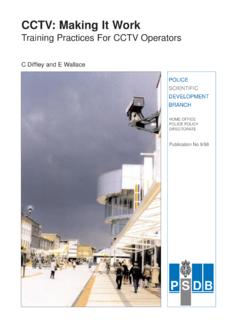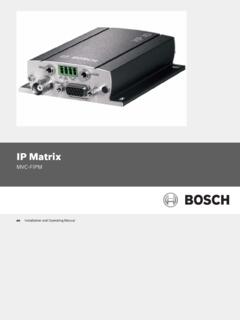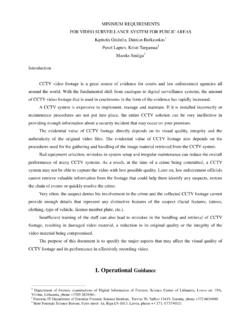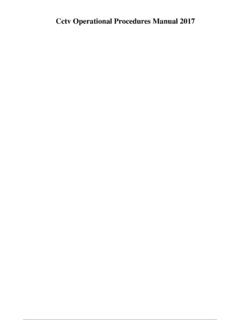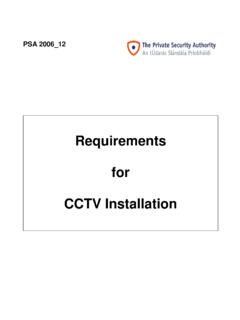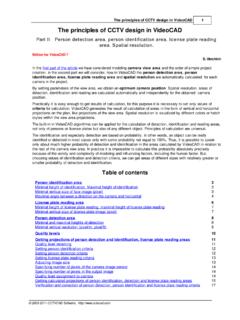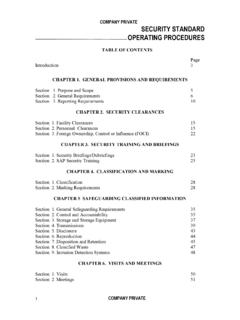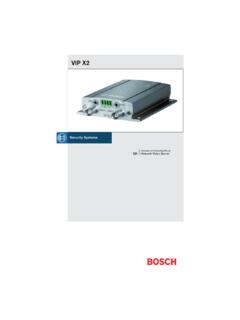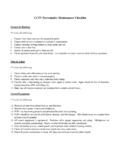Transcription of planning, design, installation and operation of CCTV ...
1 Planning, design, installation and operation of cctv surveillance systems code of practice and associated guidance Issue 4. July 2014. For other information please contact: British Security Industry Association t: 0845 389 3889. f: 0845 389 0761. e: Form No. 109 This document is the copyright of the BSIA and is not to be reproduced without the written consent of the copyright owner. Contents 1 INTRODUCTION 6. 2 SCOPE 7. 3 REFERENCED STANDARDS AND DOCUMENTS 7. 4 DEFINITIONS AND ABBREVIATIONS 8. Definitions 8. cctv System 8. Company 8. Surveillance 8. Abbreviations 8. 5 FLOWCHART 9. 6 PLANNING 9. Flowchart 9. Capturing user need 10. Threat, vulnerability, risk assessment 10.
2 Establishing operational requirements and agreeing with customer 11. Target Capture and Image Detail 12. Environmental considerations 13. Regulations and Legal requirements relevant to cctv 14. 7 DESIGN 15. Flowchart 15. Site Survey 15. General 15. Lighting 15. Other Considerations 16. Equipment Selection 16. General 16. Camera and lens 17. Powering 18. Video performance 18. Issue 4 | July 2014 Page 2 of 60. Storage Characteristics 19. Image Presentation 19. System Design Proposal Including Site Plan 19. Video transmission capability (including wireless) 20. 8 installation 21. Flowchart 21. Equipment evaluation (When is a FAT needed) 21. Equipment mounting, cabling, power-up, configuration 21.
3 Power Supplies 21. Cable installation 21. Camera Equipment 22. Control and Recording Equipment 23. Display Screens 23. Commissioning, Handover and Documentation 24. General 24. Commissioning and Testing 24. Handover 25. Documentation 25. 9 MAINTENANCE 26. 10 operation 26. Introduction and operation Flowchart 26. Monitoring 27. Control rooms general 27. Control rooms BS 7958 27. Control rooms BS 5979 and BS 8591 28. Control rooms BS 8418 28. Training of operators to gain effective use 28. Procedures for data protection and authorisation of access 28. Incident Response 29. General 29. Making the response 29. Timescale of the response 29. Result of a successful response to the incident 29.
4 Issue 4 | July 2014 Page 3 of 60. Recording quality and storage/retention time 30. General 30. Media use, storage and disposal 30. Recorded material register 30. Databases 31. Exporting recordings 31. Review of operational needs 31. Annex A The Condensed Code 32. Annex B Overall Flowchart 48. Annex C Surveillance Camera Code of Practice - 12 Guiding Principles 49. Annex D Regulation and Acts of Parliament 50. Annex E Screen Size and Position 52. Annex F Commissioning Checklist 54 Annex G Handover Checklist and Acceptance document 56. Annex H Police Form 57. Issue 4 | July 2014 Page 4 of 60. Acknowledgments The BSIA acknowledge the assistance given by the following member companies for the development of this guide: Peter Stanton ADT Fire & Security Simon Adcock ATEC Security Pauline Norstrom Dedicated Micros David Stones Secure One Mark Wherrett Synectics Colin Walters UTC Fire & Security Carlton Moore Xtralis UK.
5 BSIA also acknowledge the assistance given by the Home Office Centre for Applied Science and Technology (formerly HOSDB). document Conventions Text shown in this style forms the Code of Practice section of this document . Text shown in this style forms the associated guidance to help the readers understand the code of practice. document CHANGE HISTORY. Issue Date Description 1 18/09/1987 First publication. 2 01/10/1991 Updated to reflect current working practice. 3 28/02/2014 Complete Revision and update taking into account Surveillance Camera Commissioner's Code of Practice and introduction of BS. EN 62676 series of standards. 4 11/07/2014 Correction made to Table 1 to reflect current pixel per metre value for Inspect.
6 Issue 4 | July 2014 Page 5 of 60. 1. Introduction cctv surveillance systems are frequently the subject of debate. Some parties seek to promote their benefits such as their use in criminal investigations and providing a feeling of safety to the public. They have also been on the receiving end of bad press when some consider intrusiveness has outweighed the benefits. The correct design and use of such systems is paramount to ensure a cctv surveillance system meets the needs of the user, provides a tangible benefit and provides safety and security for the wider law-abiding public. This code of practice has been prepared to assist in this process by taking account of the various standards for cctv systems, and presenting them in a useable framework showing the building blocks necessary to achieve an effective security surveillance solution.
7 This document will be of use to many key stakeholders, all of which need to be considered at the planning and design stages, such as those shown in Figure 1: Figure 1: Key Stakeholders for cctv Surveillance Insurers Inspection Specifiers Installer / maintainer1. cctv . surveillance system Owners / Operators Monitoring Police & Justice Public System 1. Recommendations for maintenance can be found in BSIA Form 120. In the UK, The Home Office and The Scottish Government have recognised the potential for appropriate and effective use of cctv . systems. There is regulation included in the Protection of Freedoms Act: 2012. One of its legislative requirements is the development of the Surveillance Camera Commissioner's Code of practice, to which this document shares the same goal.
8 For Scotland, the Scottish Government published A National Strategy for Public Space in Scotland in 2011 which includes a standards and regulatory framework. Cross references to the 12 Guiding principles of the Surveillance Camera Commissioners (SCC) Code of Practice (CoP) are shown by boxes at the start of relevant sections. In this document , reference is made to both European (CENELEC) and International (IEC) Standards1 that introduce the concept of grading of cctv systems. Grading is considered to be risk dependant, which may differ for certain parts of a cctv system, therefore introducing the possibility of having different grades within one cctv system.
9 At the time of writing there is uncertainty over how grading will be applied in practice. Therefore grading need not feature in a cctv system unless specified in its operational Requirement. BSIA are developing guidance on this matter and expect to publish details separately on introduction of the standards to the UK market. 2. Developed by BS EN in the 62676 series are published in the UK as BS EN 62676. Issue 4 | July 2014 Page 6 of 60. 2. Scope This code of practice gives recommendations for the planning, design, installation and operation of all cctv surveillance systems. Its content takes into account the work undertaken by both the International Electrotechnical Committee (IEC), European committee for electrotechnical standardisation (CENELEC) and British Standards Institution (BSI).
10 The content of this Code of Practice should assist with compliance with the Home Office Surveillance Camera Code of Practice. Recommendations for maintenance of cctv systems are outside the scope of this document and can be found in BSIA Form 120. 3. Referenced Standards and Documents SC CoP Guiding Principle 8 states: Surveillance camera system operators should consider any approved operational , Principles technical and competency standards relevant to a system and its purpose and work to meet and maintain (see ANNEX C) those standards. The following referenced standards and documents will assist in application of this Code of Practice. Note: The 62676 series of standards were developed by the IEC as international standards but published in the UK as BS EN standards.


